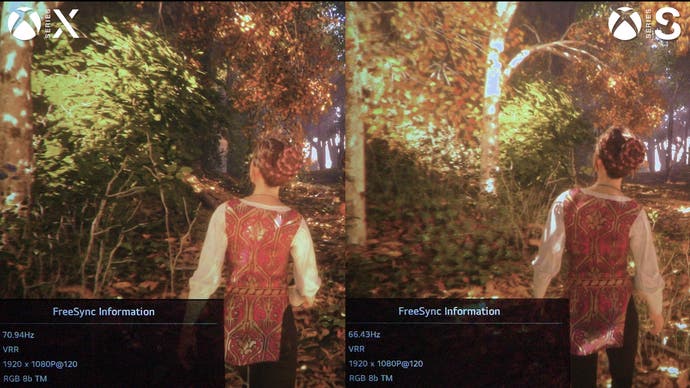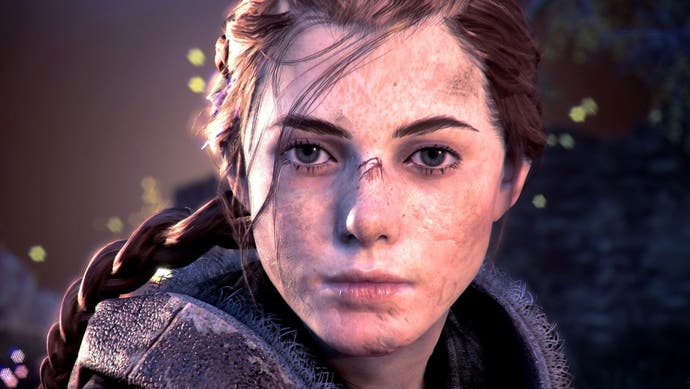A Plague Tale: Innocence's 60fps upgrade tested - and there's a bonus for Xbox Series owners
Stealth 120Hz support for Microsoft consoles examined.
On the face of it, this particular tech review should be fairly straightforward - Asobo Studio's A Plague Tale: Innocence was one the great sleeper hits of 2019. The custom engine powering it delivers a simply beautiful experience, but like many last-gen titles it was capped to 30fps. The 'next-gen' patch upgrades the game to 60 frames per second, whether you're gaming on PS5 or either of the Xbox Series consoles - but what the developer didn't tell you is that the Microsoft machines also benefit from a stealth 120Hz feature too.
In essence, the blueprint for A Plague Tale: Innocence seems to be the last-gen Xbox One X rendition of the game, which was the best console version available at the time. It rendered the experience at a native 1440p resolution, using temporal super-sampling to deliver an effective presentation for 4K displays - and that's the same target Asobo aims for with the PS5 and Series X upgrades. From there, Asobo adds some additional upgrades to the visuals, while at the same time dialling back one particular setting - a set-up that's the same on both PlayStation 5 and Xbox Series X, which are effectively interchangeable from a visual standpoint.
Let's talk about the additional enhancements first. Yes, frame-rate increases from 30fps to 60fps, doubling visual feedback and lowering input latency. However, additional fluidity is added via the welcome addition of motion blur. Camera movement now adds a velocity-based blur - missing on Xbox One X - with independent per-object motion blur added to the mix. And as a plus, it helps to disguise the ghosting artefacts of its TAA technique, working well with Plague Tale's grey, overcast aesthetic. Motion blur easily goes in the plus column for me in this case - the only minus point being that there's no toggle to turn it off, which may frustrate some. Speaking of post-processing, the game also has a particularly intense form of chromatic aberration, but there is an option to dial it down, which I'd personally recommend using.
Other enhancements to the PS5 and Series X versions include higher grade shadow maps with clearer, more defined outlines. Also, ambient occlusion is subtly improved, adding more defined pockets of self-shadowing on character jewellery, hair ringlets and more. It's a thicker self-shadow for Series X and PS5, and certainly a higher setting than Xbox One X could push. The only pitfall here really is that screen-space shadowing - and reflections too - don't use a precise method to draw each effect. You'll see clear gaps, where the shading or reflections break up towards the edges of the screen. It's an expected trait of SSAO and screen-space reflections, but sticks out given the standard of these techniques today. Still - shadows and ambient occlusion are upgraded for PS5 and Series X alike here.
The area where Xbox One X pulls ahead is in grass draw distance, where we find both PS5 and Series X noticeably downgraded. It's more obvious in cutscenes, but it extends to gameplay as well. Quite why this is the case is uncertain. Perhaps it's an oversight, but perhaps it was required to ensure a tighter lock to 60 frames per second. The other alternative is that the base settings used are actually derived and built out from the last-gen base consoles. It's all hypothetical, but it is what it is: grass is fuller and richer on the older Xbox, which in turn misses out on the higher grade motion blur, shadows and ambient occlusion of PS5 and Series X.
Xbox Series S also targets 60 frames per second, but does so from a native 900p starting point, which again uses temporal supersampling to upscale to 1080p. This gives it a much softer image as a result, but it does retain the nice-looking motion blur. However, other elements are pared back: draw distance parameters take a small hit, while ambient occlusion and shadow maps are more on par with the last-gen game. Series S still looks great, regardless. You'd be hard pressed to find issue with it judged on its own terms.
Performance? The key takeaway is that, on all three new consoles, you're getting the advertised 60 frames per second for the vast majority of the experience. However, how 60fps is achieved seems to vary. On all platforms, there can be dips beneath - sometimes accompanied by screen-tearing and sometimes not. There is no outright 'winner' between Series X and PlayStation 5. Some scenes will drop frames on one system, but not on the other - and vice versa. Series S is slightly less consistent than its stablemates but the frame-rate upgrade delivered here does the job as intended.
But what to make of the 120Hz support in the game on Xbox machines? There is the sense that perhaps it is unintentional and may well be an oversight or even a bug - it has not been marketed at all, but the fact is it's a boon for Xbox console owners. Boot the game with 120Hz set on the dashboard and frame-rate is unlocked on both Series S and Series X. On a standard 120Hz screen, it presents like a PC game with v-sync turned off with the renderer running flat-out, in essence becoming a benchmark of sorts. Unfortunately, this does mean that screen-tearing is ever-present, which can be off-putting. However, if you have a variable refresh rate (VRR) display, the tearing is gone and the presentation is so much improved as a result. VRR is a must for using this mode.

Looking at the game running unlocked, you get an idea of the headroom available beyond 60fps. In denser areas, like the forest in the tutorial mission, the game hits 65-70fps on Series X, with Series S running a little slower. However, other interior areas of the game hit 90fps, with performance moving north of 100fps in less taxing areas. It's an interesting little bonus (and thanks to GAMEKOD3 for bringing it to our attention) and assuming it's not patched out, will be an interesting test to return to in the years ahead when we would assume that new Xbox hardware will appear.
Finally, we should talk about loading times - and it's good news for all tested machines. A level that takes 58 seconds to load on Xbox One X completes in just over 15 seconds on all three of the new consoles. So, yes, the faster SSD storage really counts for a big leap in this case - though again, the game streams in the world seamlessly after that point, so it's not as if loading was a major bottleneck on the last-gen renditions of the title.
Ultimately though, it's great to have A Plague Tale: Innocence back in this newly revised form. It's currently free for PlayStation Plus subscribers, and it's also available on Xbox Game Pass too - meaning that there's plenty of ways to easily access the game. The icing on the cake? If you already own it, the 60fps upgrade is free - and this excellent upgrade is as good an excuse as any to revisit a terrific game.











